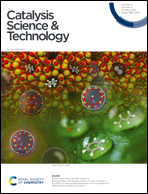Theoretical study on substrate recognition and catalytic mechanisms of gephyronic acid dehydratase DH1†
Abstract
Dehydratase (DH), a domain in polyketide synthase (PKS) modules, can catalyze the dehydration of β-hydroxy to an α,β-unsaturated acyl intermediate. As the first dual-function (dehydratase/isomerase) DH domain accessible in the PDB database, the gephyronic acid (GphF) DH1 domain from the PKS biosynthetic pathway attracts great attention from researchers. However, the mechanisms of dehydration and isomerization in type I PKS still remain unclear. In this study, MD simulations and QM/MM calculations were combined to elucidate the molecular mechanism of GphF DH1. The results indicated that GphF DH1 had better recognition effect towards the (2R,3R)-substrate and preferred forming the α–β double bond in advance to the β–γ double bond directly. By calculating the binding energy, some key residues near the active pocket were highlighted. Umbrella sampling results showed that non-methylated substrates could form intra-molecular hydrogen bonds more easily than α-methyl substrates. The QM/MM calculations with the M062X/6-311+G**//M062X/6-31G* method and SMD solvation correction supported the one-base dehydration and one-base isomerization mechanism with energy barriers of 27.0 kcal mol−1 and 17.2 kcal mol−1, respectively. These results can encourage future studies for the comprehensive understanding of the catalytic mechanism of PKS DHs and for the rational design of typical DHs.



 Please wait while we load your content...
Please wait while we load your content...